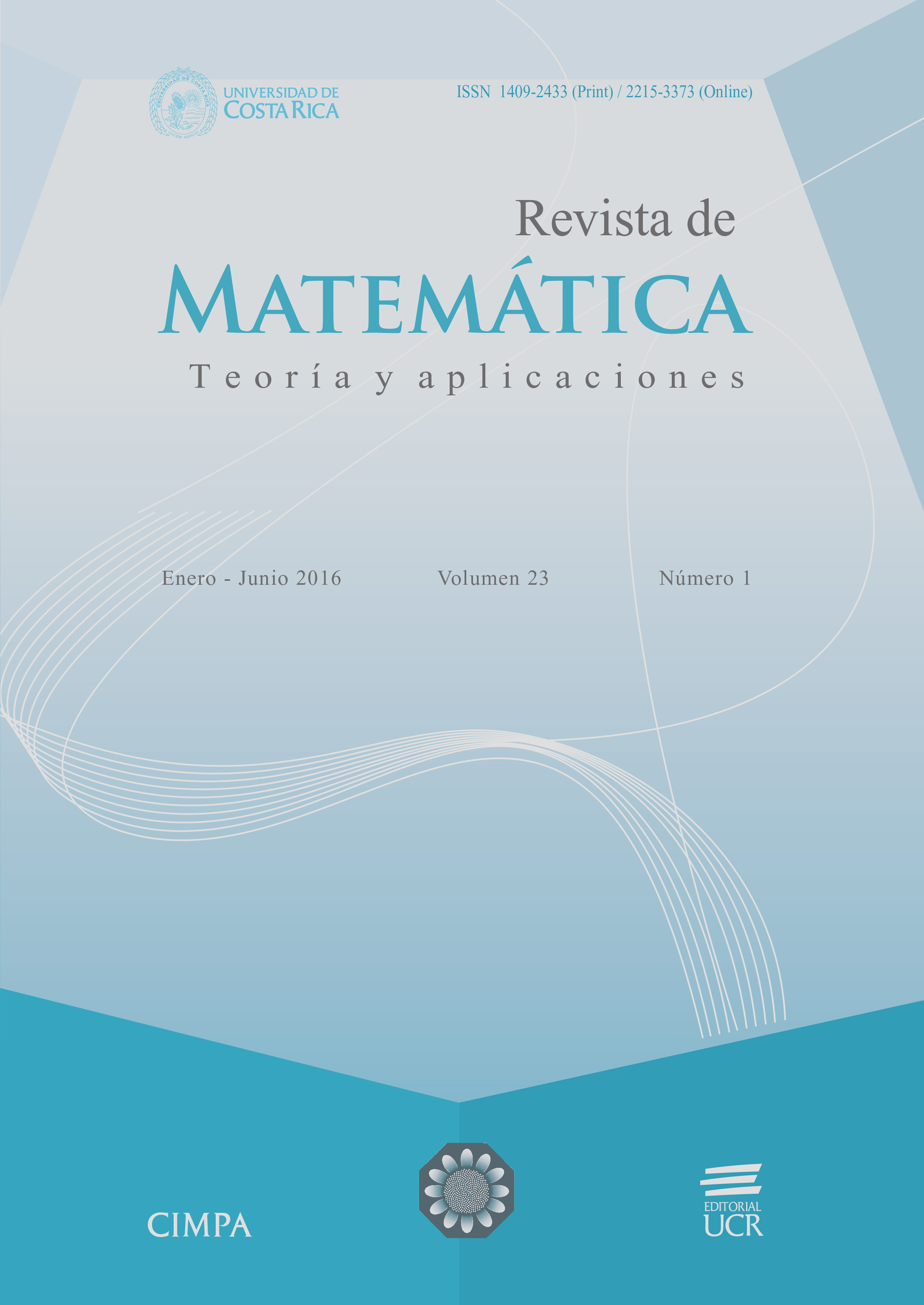Abstract
In this paper a novel fuzzy convergence system (SC) and its fundamentals are presented. The model was implemented on a monoobjetive PSO algorithm with three phases: 1) Stabilization, 2) generation and breadth-first search, and 3) generation and depth-first. The system SC-PSO-3P was tested with several benchmark engineering problems and with several CEC2006 problems. The computing experience and comparison with previously reported results is presented. In some cases the results reported in the literature are improved.
References
Aragon, V.S.; Coello, C.A.C. (2010) “A modified version of a t-cell algorithm for constrained optimization problems”, Int. J. Numer. Methods Eng. 84(3): 351–378.
Belegundu, A.D. (1982) A Study of Mathematical Programming Methods for Structural Optimization. Ph.D. Thesis, Department of Civil Environmental Engineering, University of Iowa, Iowa City.
Coello, C.A.C. (2000) “Use of a self-adaptive penalty approach for engineering optimization problems”, Comput. Ind. 41(2): 113–127.
Deb, K. (1991) “Optimal design of a welded beam via genetic algorithms”, AIAA J. 29(11): 2013–2015.
de-los-Cobos-Silva, S.G. (2015) “SC: system of convergence. Theory and fundaments”, Revista de Matemática: Teoría y Aplicaciones 22(2): 341–367.
Dubois, D.; Prade, H. (1978) “Operations on fuzzy numbers”, International Journal of Systems Science 9(6): 613–626.
Elsayed, S.M.; Sarker, R.A.; Essam, D.L. (2012) “On an evolutionary approach for constrained optimization problem solving”, Applied Soft Computing 12(10): 3208–3227.
Gavana, A. (2007?) “Global optimization benchmarks and AMPGO. Test functions”, in: http://infinity77.net/global_optimization/
Glover, F. (1989) “Tabu search, Part I”, ORSA Journal on Computing 1(3): 190–206.
Glover, F. (1998) “A template for scatter search and path relink”, in: J.K. Hao, E. Lutton, E. Ronald, M. Schoenauer & D. Snyers (Eds.) Artificial Evolution, Lecture Notes on Computer Science 1363, Springer, Berlin: 1–51.
He, Q.; Wang, L. (2007a) “An effective co-evolutionary particle swarm optimization for constrained engineering design problems”, Eng. Appl. Artif. Intell. 20(1): 89–99.
He, Q.; Wang, L. (2007b) “A hybrid particle swarm optimization with a feasibility-based rule for constrained optimization”, Appl. Math. Comput. 186(2): 1407–1422.
Hedar, A.R. (2007?) “Global optimization test problems”, in: http://www-optima.amp.i.kyoto-u.ac.jp/member/student/hedar/Hedar_files/go.htm
Hibbeler, R.C. (2000) Mechanics of Materials, 8th ed. Prentice Hall, New Jersey.
Holland, J.H. (1975) Adaptation in Natural and Artificial Systems. University of Michigan Press, Ann Arbor MI.
Imran, M.; Hashima, R.; Khalid, N.E.A. (2013) “An overview of particle swarm optimization variants”, Procedia Engineering 53: 491–496.
Kalami Heris, S.M. (s.f.) “S. Mostapha Kalami Heris’ homepage”, http://www.kalami.ir
Kannan, B.K.; Kramer, S.N. (1994) “An augmented Lagrange multiplier based method for mixed integer discrete continuous optimization and its applications to mechanical design”, J. Mech. Des. 116(2): 405–411.
Kennedy, J.; Eberhart, R. (1995) “Particle swarm optimization”, in: Proc. of the IEEE International Conference on Neural Networks, vol. 4: 1942–1948.
Kennedy, J.; Eberhart, R.C.; Shi, Y. (2001) Swarm Intelligence. Morgan Kaufmann, San Francisco.
Kirkpatrick, S.; Gelatt, C.; Vecchi, M. (1983) “Optimization by simulated annealing”, Science 220: 671–680.
Liang, J.J.; Runarsson, T.P.; Mezura-Montes, E.; Clerc, M.; Suganthan, P.N.; Coello Coello, C.A.; Deb, K. (2006) “Problem definitions and evaluation criteria for the CEC 2006, special session on constrained real-parameter optimization”, Technical Report, IEEE Congress on Evolutionary Computation, 24 pp.
Liou, T.S.; Wang, M.J.J. (1992) “Ranking fuzzy numbers with integral value”, Fuzzy Sets and Systems 50(3): 247–255.
Liu, C.A. (2007) “New multiobjective PSO algorithm for nonlinear constrained programming problems”, in: R. Wang, E. Shen E. & F. Gu (Eds.) Advances in Cognitive Neurodynamics ICCN: 955-962.
Liu, H.; Cai, Z.; Wang, Y. (2010) “Hybridizing particle swarm optimization with differential evolution for constrained numerical and engineering optimization”, Appl. Soft Comput. 10(2): 629–640.
Lu, H.; Chen, W. (2008) “Self-adaptive velocity particle swarm optimization for solving constrained optimization problems”, J. Glob. Opt. 41(3):427–445.
Mazhoud, I.; Hadj-Hamou, K.; Bigeon J.; Joyeux P. (2013) “Particle swarm optimization for solving engineering problems: a new constraint-handling mechanism”, Eng. Appl. of Art. Intel. 26(4): 1263–1273.
Mezura-Montes, E.; Velázquez-Reyes, J.V.; Coello-Coello, C.A. (2006) “Modified differential evolution for constrained optimization”, in: IEEE Congress on Evolutionary Computation: 25–32.
Mezura-Montes, E.; Miranda-Varela, M.E.; Gómez-Ramón, R.C. (2010) “Differential evolution in constrained numerical optimization: An empirical study”, Inf. Sci. 180(22): 4223–4262.
Rao, S.S. (1996) Engineering Optimization: Theory and Practice. Wiley, New York.
Sedighizadeh, D.; Masehian, E. (2009) “Particle swarm optimization methods, taxonomy and applications”, Int. Journal of Computer Theory and Engineering 1(5): 486–502.
Tessema, B.; Yen, G.G. (2009) “An adaptive penalty formulation for con- strained evolutionary optimization”, IEEE Transactions on Systems, Man and Cybernetics, Part A: Systems and Humans 39(3): 565–578.
Toscano-Pulido, G.; Coello, C.A.C. (2004) “A constraint-handling mechanism for particle swarm optimization”, in: IEEE Congress on Evolutionary Computation, vol. 2, IEEE Press: 1396–1403.
Zitzler, E.; Deb, K.; Thiele, L. (2000) “Comparison of multiobjective evolutionary algorithm: empirical results”, Evolutionary Computation 8(2): 173–195
Wang, Y.; Cai, Z.; Zhou, Y. (2009) “Accelerating adaptive trade-off model using shrinking space technique for constrained evolutionary optimization”, Int. J. Numer. Methods Eng. 77(11): 1501–1534.
